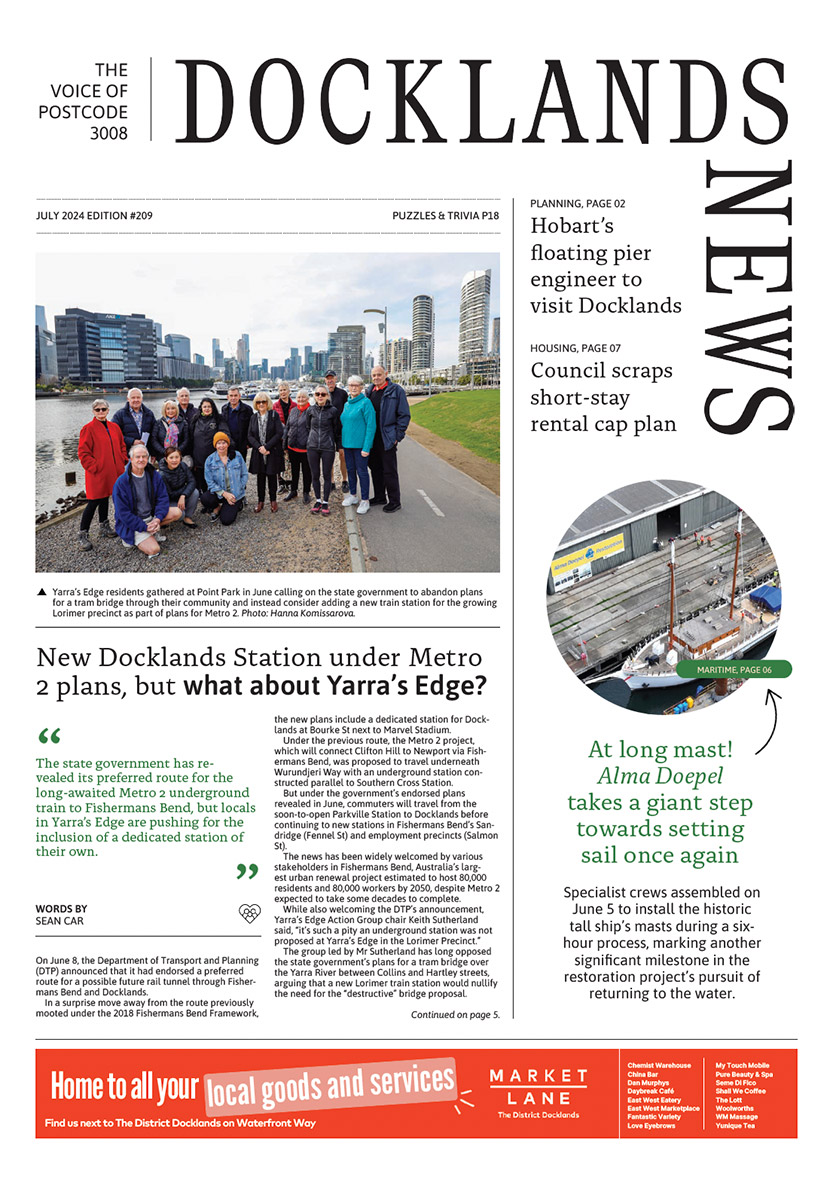An apple a day keeps the docks busy
By Ashley Smith - Royal Historical Society of Victoria
For any fruit-grower in the 1900s, hoping their hard labour would pay off with big overseas sales, this scene (taken around 1908) would’ve been a nerve-wracking time.
Regardless of whether the apple was a Jonathan, a Cleopatra, an Annie Elizabeth or a London Pippin, each apple was thoroughly inspected at the Melbourne Docks before being shipped to overseas markets.
By the 1900s, the Docklands area had become a hive of activity due to both the excavation of the Coode Canal in the 1880s and the opening of Victoria Dock in 1892. These developments allowed access for bigger ships to deliver their larger cargos directly into Melbourne. The docks were also dealing with goods for export arriving through the neighbouring Spencer Street Station. The cargo would then be sent on a multi-week trip by sea to Britain or our other trade partners where Australian produce was usually in high demand.
By 1908, more than £19 million worth of produce (or more than $2.8 billion today) had been exported from Victoria though the state’s apple industry faced stiff competition. Writing for the Department of Agriculture’s Journal of Agriculture in 1908, senior inspector for imports and exports J.G. Turner noted that despite the UK importing foreign fruit valued at more than £9 million (or more than £1 billion today) by 1905, Victoria only “contributes only one case out of every thousand”. With Turner also warning of emerging competition from the Cape Colony (South Africa) and the Argentine Republic, it was necessary that Victorian apple-growers grow the finest quality fruit to gain a competitive edge.
At the time, the handling of fruit and other food exports in Victoria was determined by several laws. Inspection of produce and other food products was covered by the Victorian Parliament’s Exported Products Act 1898, and the federal government’s Commerce (Trade Descriptions) Act 1905. Under the latter, a customs officer had privilege to investigate cargo, take samples, and penalise up to £100 if there was a false trade description concerning the goods. Meanwhile, food under the 1898 Act had to be approved with a certificate that guaranteed it was disease-free, with any false certificates resulting in a 12-month stint behind bars. Another law was Victoria’s Fruit Cases Act 1906, which not only determined the size of packing crates, but that they had to be marked with the producer’s name and address and their quantity (usually one “imperial bushel”).
This latter law is evident in this photograph where the boxes reveal the apples to be from Harcourt, which had been known for its orchards since the 1850s. By 1886, England had taken notice of the small town, after James Lang’s apples were awarded a silver medal by the Royal Horticultural Society of England during a Colonial and Indian Exhibition. By the 1930s Harcourt was exporting around 400,000 cases of apples and pears outside Victoria each year. Even wartime didn’t stop Harcourt from reminding our troops of home, as was the case with Sergeant Albert Ball. The Bendigonian on July 18, 1918, features a letter from Ball (in France) to J. Warren of Harcourt on a delivery of apples he received. Other than some “slightly withered” Jonathans, he praised their quality, remarking they were “absolutely splendid, and most delicious.”
To make sure the fruit was able to pass the inspector’s seal of approval in both colour, size, and lack of disease, many factors had to be considered. Turner’s 1908 article also lists the many ways the fruit’s quality could be maximised for export. This included cooling the fruit in the shade to avoid condensation and avoiding cutting off the stems which would allow “germs of decay to enter”. It was recommended that apples were wrapped in tissue paper and their stacked, well-ventilated wooden crates were to be covered in shaved paper or “wood-wool” to minimise bruising and direct handling. However, even the finest packed apples were not guaranteed to return a profit. Reporting on a failed export season for 1907 in the Journal of Agriculture, inspector Ernest Meeking blamed the quantity of competing fruit, the comparative inferiority of Victorian fruit, and England’s cold weather after Easter causing a low demand for fruit. Meeking also identified that ships needed to take better care of their refrigeration facilities, as fluctuations in temperature could affect the quality of fruit.
When this photograph was taken, Docklands was just about to embrace refrigeration, an emerging technology in food storage. 1911 saw the construction of a new government cool store along the north side of Victoria Dock. When it opened in 1914, the Bendigo Advertiser reported that their 310,000 cubic feet (8778 cubic metres) of space could hold “155,000 boxes of butter, or 140,000 carcasses of mutton and lamb, and 105,000 cases of fruit” and had a refrigerating plant powered by 11 electric motors. This received opposition by the fruit-growers, who complained that pre-cooling the fruit would shorten their export season, and likely disrupt the quality of the fruit. Regardless of what the growers believed the cool stores remained a staple in preserving meat, dairy and fruit goods for the next seven decades (despite a fire in 1937), until its closure in 1978 and its eventual demolition.
And all the while, lots of Inspector-approved crunchy, juicy bites were taken across the globe thanks to the growers in Harcourt and the inspectors at the docks •

New Docklands Station under Metro 2 plans, but what about Yarra’s Edge?





 Download the Latest Edition
Download the Latest Edition